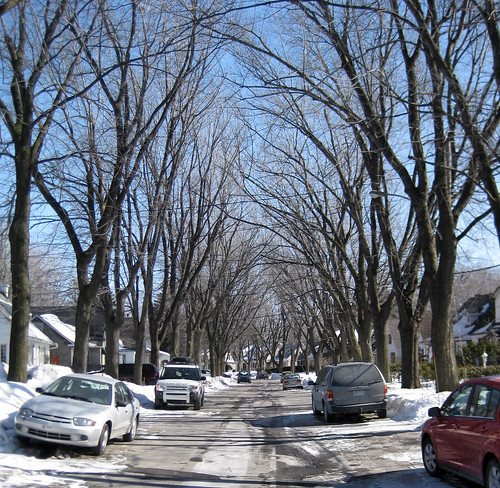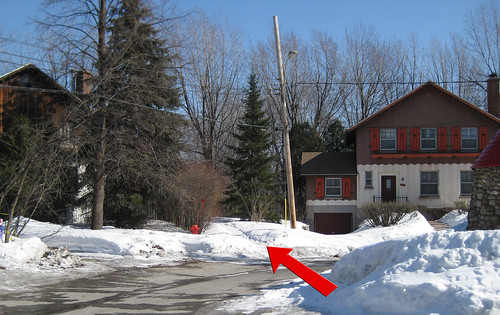There was a time, I can imagine, when suburbs were not such a terrible idea.
Ignore for a moment the gluttonous land consumption and slothful car-dependency that suburban development has brought about, and push aside the isolation, segregation and placelessness that come with single-use zoning, dead-end streets and bland look-alike homes. Perhaps you can see the shining attraction that suburbs once represented: a family-friendly community on the frontier between the bright lights of the big city and the pristine wilderness.
Rosemont’s Cité Jardin was an early experiment in suburban development and perhaps a better model than that which has sprawled over the extremities of our island and splashed onto the north and south shores. The Cité Jardin began in 1941 as a co-op that would allow middle-class families, with their numerous children, to own a small property. At the time the average buyer earned around $2,000 per year, the equivalent of $29,000 in today’s dollars. However, construction was slow and costly during the war years. In the end only 165 homes were built instead of a projected 600, and the co-op went bankrupt in 1947.
The planners adopted a model that has since come to epitomize suburban sprawl: detached, single-family dwellings clustered around dead end streets. However, unlike most suburbs, the Cité-Jardin was designed with an internal network of public spaces. Each cul-de-sac opened into a pedestrian alleyway which led to a central park (see image below).
The development also included a central building that served as office space, food co-op and chapel – a measure that would be dubbed mixed-use in today’s planning lingo. As of 1957, the central building was used as a primary school for the countless baby boomer kids that populated the neighbourhood.
Furthermore, the neighbourhood is framed with urban boulevards (Viau, Assomption and Rosemont), which are served by public transit.
All of this, I knew ahead of time from the community’s website, so when I set out to wander about Rosemont’s Cité Jardin I departed with an optimistic attitude. Here kids can roam freely between school, park and friends’ houses without ever crossing a street and teenagers can hop on a bus when they are ready to widen their stomping ground. Parents can leave their cars in the driveway and take the metro to the office, or work in the hospital right across the street.
Could this really be a viable hybrid between city living and the suburban dream that North Americans seem unable to shake?
As I turned off busy Boulevard de l’Assomption and into the Cité Jardin, I found myself on streetscape that could easily been in some remote West Island enclave rather than a mere ten minute walk from the metro. The street names – Bouleaux, Sapins, Épinettes, etcetera – offered no further distinction. The “Garden City’s” obsession with greenery has certainly paid off, and tree branches tangled high above the rooftops.

But overall, I have to say I was a little underwhelmed. Despite the emphasis on public space in the neighbourhood design, private space was still overwhelmingly dominant. Most houses had large, fenced in backyards, many had private pools, and some even their own jungle gyms, despite the central neighbourhood park a few steps away. With the baby boomers grown up and gone, the school is now used as a centre for intellectually handicapped people rather than a proximity service.
Save our suburb?
While the Cité-Jardin began as an affordable housing project of sorts, it has since become something else.
Now residents are up in arms because once-modest homes are being renovated in a “disproportionate way” – doubling or tripling in size, and sometimes taking down 60-year old trees in the wake of construction. A citizens group has successfully pressured the borough to regulate the surface areas of homes, and enforce a minimal distance between houses, and protect the 60-year old trees.
Avenue des Cèdres: One of these houses is not like the other ones…
Of course all of these regulations ensure that the Cité Jardin remains one of the lowest density areas in the city, much to the satisfaction of local residents.
The Cité-Jardin is a unique experiment in urban planning and it remains a life-size example of how suburbs could have been (and could still be) planned differently. In this sense, perhaps it is worth preserving. On the other hand, a living laboratory could be more valuable than a static model. Is this neighbourhood resilient? Does it harbour a distinctive way of life along with a unique form? Or is it, in the end, just another suburban state of mind?




5 comments
In the ‘Leave it to Beaver’ era, which followed the ‘I Love Lucy’ era on the then-new black and white TVs a move to the suburbs was a great step forward.
No! they were not always reruns!
You got your own house, rather than renting in a bi or tri-level with a cranky old landlord below.
Oil heat rather than coke or coal. There was a generous lawn front and back, and a garage for the car, when it arrived, later. All yours!
Mortgages FIXED at 2 or 3% for the term.
Pleasant tree-lined streets with GOOD Tramways shuttle busses to the streetcar routes. Schools, libraries, places of worship AND, of COURSE, a Steinberg’s right handy by!
Still had bread, eggs, cheese and milk delivered to the door, and you could feed the horse an apple, or have to collect their offerings for the garden.
Almost little villages next to each other, but, still accessible in the old way, by public transit.
Suburbs, a BIG step forward, just after the War!
A city’s age can be determined similar to rings in a tree, seeing how the architecture of dwellings and stores change as they move out from the core.
The age of the real trees indicate, too.
At one time you could wander to the corner and get a date of the area from the maple leafs of les Duranceaux implanted in the sidewalks.
Once cars became common, suburbs went wild, and became remote. Lots became smaller. The thought of living in a suburb far from the core WITHOUT a car is a scary concept.
We were fortunate that the 102 went right by, and getting downtown was not a problem. Montreal West station was within earshot, and could hear the engines chuffing their way East up to the summit near Grand.
I wonder what people do in a way-out suburb, now? if they don’t want to drive in the traffic and deal with the bridges or the Met.
Without Satellite TV, MP3s, iPods and XBox 360s it would be purgatory to some. Elba in the Suburbs? Elba???
Sounds almost insular, something like Me First?
Things have changed. Who almost DARES to walk in some areas? Time, broken marriages and drugs have changed values.
Walking to school was safe and normal, but, is it, now? Does anyone walk? Never seem to see anyone when passing thru some areas. Parks are empty.
Elba in the suburbs?
Elba can also exist in a high rise appartment at $2300 a month, with a six lane mega-highway right out front the door, looking across the road to yet another monolith.
Maunderings on change.
Interesting article! Suburbs are essential today for many people – try bringing up kids in a small condo on the third floor with two flights of outdoor steps. It’s really not easy at all. So there are great advantages to having a spacious house in the suburbs.
Not all are bland – some are awful – look at a lot of the new development in Brossard, for example; it’s high density suburban living (what’s the point???). La Prairie has a lot more space and variety of housing. What the suburbs really miss is the ability to walk easily to shops, cafés etc.
Montréal has been quick to allow suburbs but slow to connect them to the core. Although there is a desire to improve public transport and some excellent schemes, there is still a long way to go.
Definitely agree with the last post. I myself am not a suburb person, but I do see their value.
I agree that Montreal is a little behind in suburb integration. I currently live in Paris, where the public transportation network is so integrated, it makes ours look like a joke. There are so many trains, metros and RERs diverging into the city that you really don’t need to drive your car into the city every day.
Suburbs are essential to keep housing affordable off and on the island, imagine if everyone lived on the island. It would be insanely expensive to everyone. And the life quality not so great IMO.
Bland looking homes? I think its in the eye of the beholder, I remember touring the town with my buddy who came from oversea and he found most of the central city residential areas grim and boring, all triplexes, all looking the same. :)
I grew up in Cité-Jardin in the sixties and seventies. The fences were fewer and we could run from park to house to house. I smoked my first joints in the central park. There was a sense of community at the time, with a mix of original owners from the 40’s and doctors from the Maisonneuve hospital nearby. But the rich slowly bought up everything and changed those little modest houses into something else with fenced swimming pools. And I can’t afford to live there anymore.